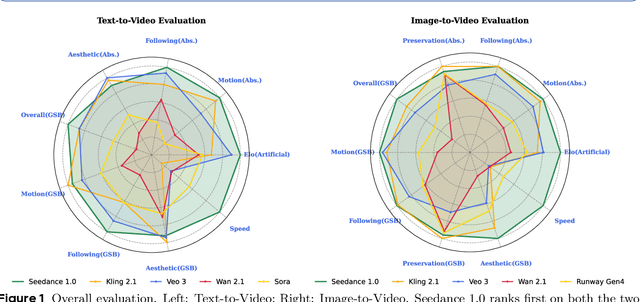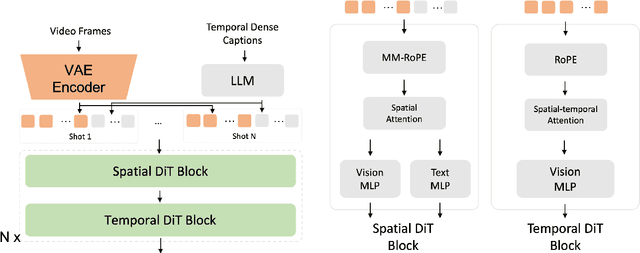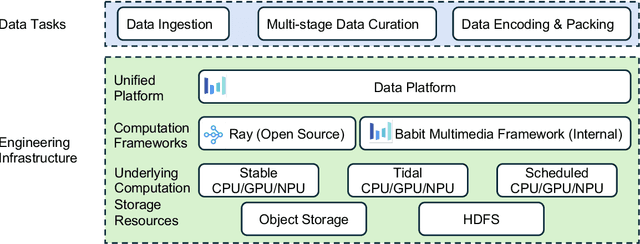Zilyu Ye
RewardDance: Reward Scaling in Visual Generation
Sep 10, 2025Abstract:Reward Models (RMs) are critical for improving generation models via Reinforcement Learning (RL), yet the RM scaling paradigm in visual generation remains largely unexplored. It primarily due to fundamental limitations in existing approaches: CLIP-based RMs suffer from architectural and input modality constraints, while prevalent Bradley-Terry losses are fundamentally misaligned with the next-token prediction mechanism of Vision-Language Models (VLMs), hindering effective scaling. More critically, the RLHF optimization process is plagued by Reward Hacking issue, where models exploit flaws in the reward signal without improving true quality. To address these challenges, we introduce RewardDance, a scalable reward modeling framework that overcomes these barriers through a novel generative reward paradigm. By reformulating the reward score as the model's probability of predicting a "yes" token, indicating that the generated image outperforms a reference image according to specific criteria, RewardDance intrinsically aligns reward objectives with VLM architectures. This alignment unlocks scaling across two dimensions: (1) Model Scaling: Systematic scaling of RMs up to 26 billion parameters; (2) Context Scaling: Integration of task-specific instructions, reference examples, and chain-of-thought (CoT) reasoning. Extensive experiments demonstrate that RewardDance significantly surpasses state-of-the-art methods in text-to-image, text-to-video, and image-to-video generation. Crucially, we resolve the persistent challenge of "reward hacking": Our large-scale RMs exhibit and maintain high reward variance during RL fine-tuning, proving their resistance to hacking and ability to produce diverse, high-quality outputs. It greatly relieves the mode collapse problem that plagues smaller models.
Seedance 1.0: Exploring the Boundaries of Video Generation Models
Jun 10, 2025



Abstract:Notable breakthroughs in diffusion modeling have propelled rapid improvements in video generation, yet current foundational model still face critical challenges in simultaneously balancing prompt following, motion plausibility, and visual quality. In this report, we introduce Seedance 1.0, a high-performance and inference-efficient video foundation generation model that integrates several core technical improvements: (i) multi-source data curation augmented with precision and meaningful video captioning, enabling comprehensive learning across diverse scenarios; (ii) an efficient architecture design with proposed training paradigm, which allows for natively supporting multi-shot generation and jointly learning of both text-to-video and image-to-video tasks. (iii) carefully-optimized post-training approaches leveraging fine-grained supervised fine-tuning, and video-specific RLHF with multi-dimensional reward mechanisms for comprehensive performance improvements; (iv) excellent model acceleration achieving ~10x inference speedup through multi-stage distillation strategies and system-level optimizations. Seedance 1.0 can generate a 5-second video at 1080p resolution only with 41.4 seconds (NVIDIA-L20). Compared to state-of-the-art video generation models, Seedance 1.0 stands out with high-quality and fast video generation having superior spatiotemporal fluidity with structural stability, precise instruction adherence in complex multi-subject contexts, native multi-shot narrative coherence with consistent subject representation.
Schedule On the Fly: Diffusion Time Prediction for Faster and Better Image Generation
Dec 02, 2024



Abstract:Diffusion and flow models have achieved remarkable successes in various applications such as text-to-image generation. However, these models typically rely on the same predetermined denoising schedules during inference for each prompt, which potentially limits the inference efficiency as well as the flexibility when handling different prompts. In this paper, we argue that the optimal noise schedule should adapt to each inference instance, and introduce the Time Prediction Diffusion Model (TPDM) to accomplish this. TPDM employs a plug-and-play Time Prediction Module (TPM) that predicts the next noise level based on current latent features at each denoising step. We train the TPM using reinforcement learning, aiming to maximize a reward that discounts the final image quality by the number of denoising steps. With such an adaptive scheduler, TPDM not only generates high-quality images that are aligned closely with human preferences but also adjusts the number of denoising steps and time on the fly, enhancing both performance and efficiency. We train TPDMs on multiple diffusion model benchmarks. With Stable Diffusion 3 Medium architecture, TPDM achieves an aesthetic score of 5.44 and a human preference score (HPS) of 29.59, while using around 50% fewer denoising steps to achieve better performance. We will release our best model alongside this paper.
Openstory++: A Large-scale Dataset and Benchmark for Instance-aware Open-domain Visual Storytelling
Aug 07, 2024



Abstract:Recent image generation models excel at creating high-quality images from brief captions. However, they fail to maintain consistency of multiple instances across images when encountering lengthy contexts. This inconsistency is largely due to in existing training datasets the absence of granular instance feature labeling in existing training datasets. To tackle these issues, we introduce Openstory++, a large-scale dataset combining additional instance-level annotations with both images and text. Furthermore, we develop a training methodology that emphasizes entity-centric image-text generation, ensuring that the models learn to effectively interweave visual and textual information. Specifically, Openstory++ streamlines the process of keyframe extraction from open-domain videos, employing vision-language models to generate captions that are then polished by a large language model for narrative continuity. It surpasses previous datasets by offering a more expansive open-domain resource, which incorporates automated captioning, high-resolution imagery tailored for instance count, and extensive frame sequences for temporal consistency. Additionally, we present Cohere-Bench, a pioneering benchmark framework for evaluating the image generation tasks when long multimodal context is provided, including the ability to keep the background, style, instances in the given context coherent. Compared to existing benchmarks, our work fills critical gaps in multi-modal generation, propelling the development of models that can adeptly generate and interpret complex narratives in open-domain environments. Experiments conducted within Cohere-Bench confirm the superiority of Openstory++ in nurturing high-quality visual storytelling models, enhancing their ability to address open-domain generation tasks. More details can be found at https://openstorypp.github.io/
 Add to Chrome
Add to Chrome Add to Firefox
Add to Firefox Add to Edge
Add to Edge